高中英语 A taste of English humour公开课教案 新人教版必修4
- 格式:doc
- 大小:690.50 KB
- 文档页数:2
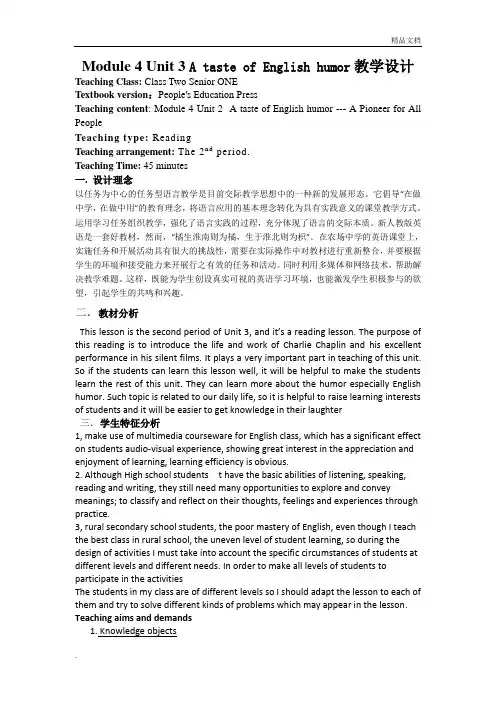
Module 4 Unit 3 A taste of English humor教学设计Teaching Class: Class Two Senior ONETextbook version:People's Education PressTeaching content: Module 4 Unit 2 A taste of English humor --- A Pioneer for All PeopleTeaching type: ReadingTeaching arrangement: The 2n d period.Teaching Time: 45 minutes一. 设计理念以任务为中心的任务型语言教学是目前交际教学思想中的一种新的发展形态。
它倡导“在做中学,在做中用”的教育理念,将语言应用的基本理念转化为具有实践意义的课堂教学方式。
运用学习任务组织教学,强化了语言实践的过程,充分体现了语言的交际本质。
新人教版英语是一套好教材,然而,“橘生淮南则为橘,生于淮北则为枳”。
在农场中学的英语课堂上,实施任务和开展活动具有很大的挑战性,需要在实际操作中对教材进行重新整合,并要根据学生的环境和接受能力来开展行之有效的任务和活动。
同时利用多媒体和网络技术,帮助解决教学难题。
这样,既能为学生创设真实可视的英语学习环境,也能激发学生积极参与的欲望,引起学生的共鸣和兴趣。
二.教材分析This lesson is the second period of Unit 3, a nd it’s a reading lesson. The purpose of this reading is to introduce the life and work of Charlie Chaplin and his excellent performance in his silent films. It plays a very important part in teaching of this unit. So if the students can learn this lesson well, it will be helpful to make the students learn the rest of this unit. They can learn more about the humor especially English humor. Such topic is related to our daily life, so it is helpful to raise learning interests of students and it will be easier to get knowledge in their laughter三.学生特征分析1, make use of multimedia courseware for English class, which has a significant effect on students audio-visual experience, showing great interest in the appreciation and enjoyment of learning, learning efficiency is obvious.2. Although High school students t have the basic abilities of listening, speaking, reading and writing, they still need many opportunities to explore and convey meanings; to classify and reflect on their thoughts, feelings and experiences through practice.3, rural secondary school students, the poor mastery of English, even though I teach the best class in rural school, the uneven level of student learning, so during the design of activities I must take into account the specific circumstances of students at different levels and different needs. In order to make all levels of students to participate in the activitiesThe students in my class are of different levels so I should adapt the lesson to each of them and try to solve different kinds of problems which may appear in the lesson. Teaching aims and demands1. Knowledge objectsMake the students be aware of the cultural aspects of humor by learning this lesson.2. Ability objects1. Develop students’ ability and let them learn different reading2. Enable students to talk about types of humors and Charlie Chaplin3. Moral objects①To enable the students to learn to be faced with difficulties and overcome them.②To encourage them to keep up optimistic attitude towards life and improve their sense of humor.Teaching key points1. Help the students grasp the reading skills.2. Help the students to learn to get information, analyze the information and understand the information from the text.Teaching difficulties1. How to fire the students’ enthusiasm to express their ideas.2. To make the students know the acting style of Charlie Chaplin and understand the connotation of humor.Teaching methods: Task-based teaching method, Skimming, Scanning and Group discussion.Teaching aids: A multi-media classroom.Teaching procedures & ways:Step 1 Lead-in (4 minutes)1.show a famous poem to students【设计说明】图片能吸引学生注意力,从而调动他们学习的积极性。
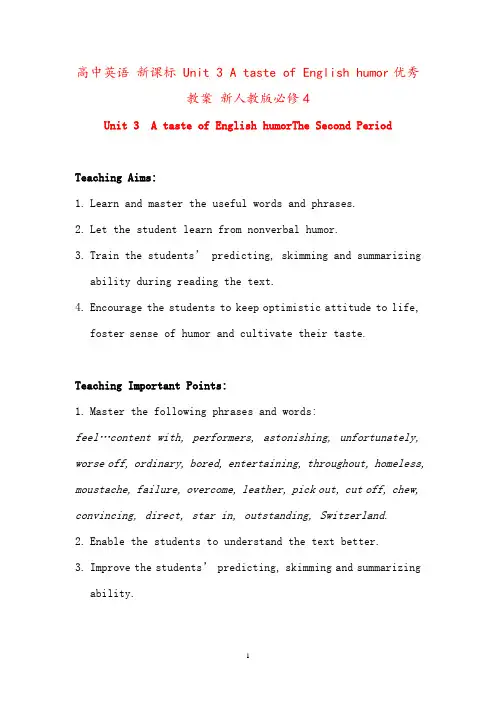
高中英语新课标 Unit 3 A taste of English humor优秀教案新人教版必修4Unit 3 A taste of English humorThe Second PeriodTeaching Aims:1.Learn and master the useful words and phrases.2.Let the student learn from nonverbal humor.3.Train the students’ predicting, skimming and summarizingability during reading the text.4.Encourage the students to keep optimistic attitude to life,foster sense of humor and cultivate their taste.Teaching Important Points:1.Master the following phrases and words:feel…content with, performers, asto nishing, unfortunately, worse off, ordinary, bored, entertaining, throughout, homeless, moustache, failure, overcome, leather, pick out, cut off, chew, convincing, direct, star in, outstanding, Switzerland.2.Enable the students to understand the text better.3.Improve the students’predicting, skimming and summarizingability.Teaching Difficult Points:1.How to make the students understand the text better.2.How to make the students understand the following sentence.Not that Charlie’s own life was easy!Teaching Methods:1.Playing the footage of The Gold Rush and asking the studentssome questions.2.Scanning the text to get some information about CharlieChaplin.3.Careful reading to summarize the main ideas of eachparagraph.4.Individual, pair or group work to make every student workin class.Teaching Aids:1.a multimedia classroom2.the blackboardTeaching Procedures:Step Ⅰ GreetingsGreet the whole class as usual.Step Ⅱ Leading-in and Pre-reading1. Review the content of last class (Comparing Chinese and western humor).2. Play the footage of The Gold Rush.3.Let the students think about and discuss the questions inthe part of Pre-reading.If the students can not answer the questions perfectly, the teacher should consummate the answer.Step Ⅲ Reading1.Let the students scan the text to get some information about Charlie Chaplin and accomplish Comprehending One.Suggested answers:Born: 1889Job: ActorFamous character: Little trampCostume: moustache, large trousers, worn-out shoes, small round black hat, walking stick.Type of acting: nonverbal humorDied: Switzerland, 19772.Let the students carefully read the text and accomplish Comprehending Two.Suggested answers:Paragraph 1: A talent comedy actorParagraph 2: LifeParagraph 3: Little trampParagraph 4: ExampleParagraph 5: AchievementStep Ⅳ DiscussionAccomplish Comprehending Three.Suggested answers:1.Yes, I think so. Because his poor childhood offered theexperience of poor life and toughened him.2.Because he brightened the lives of Americans and Britishthrough two world wars and the hard years in between, and up to now no body has been able to do this better than him.Step Ⅴ Summary and HomeworkSummary: In this class, we have read a text about a famous prince of comedy—Charlie Chaplin. We have known that Chaplin is a talent performer. We should learn optimistic attitude to life from Charlie Chaplin. We also learned some words and phrases in the text.Homework: Let the students watch one of Charlie Chaplin’s films and then work in pairs according to Comprehending Four.Step Ⅵ The Design of Writing on the blackboardUnit 3 A taste of English humorThe Second PeriodA Master of Nonverbal HumorMain BodyParagraph 1: A talent comedy actorParagraph 2: LifeStep Ⅶ Record after teaching。
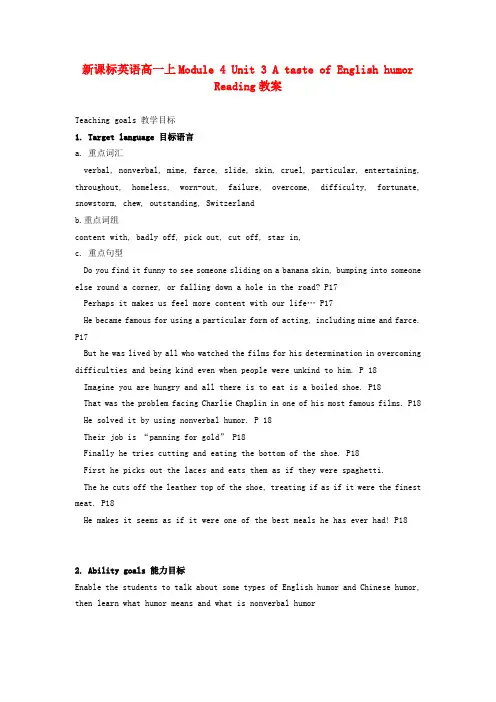
新课标英语高一上Module 4 Unit 3 A taste of English humorReading教案Teaching goals 教学目标1. Target language 目标语言a. 重点词汇verbal, nonverbal, mime, farce, slide, skin, cruel, particular, entertaining, throughout, homeless, worn-out, failure, overcome, difficulty, fortunate, snowstorm, chew, outstanding, Switzerlandb.重点词组content with, badly off, pick out, cut off, star in,c. 重点句型Do you find it funny to see someone sliding on a banana skin, bumping into someone else round a corner, or falling down a hole in the road? P17Perhaps it makes us feel more content with our life… P17He became famous for using a particular form of acting, including mime and farce. P17But he was lived by all who watched the films for his determination in overcoming difficulties and being kind even when people were unkind to him. P 18Imagine you are hungry and all there is to eat is a boiled shoe. P18That was the problem facing Charlie Chaplin in one of his most famous films. P18 He solved it by using nonverbal humor. P 18Their job is “panning for gold” P18Finally he tries cutting and eating the bottom of the shoe. P18First he picks out the laces and eats them as if they were spaghetti.The he cuts off the leather top of the shoe, treating if as if it were the finest meat. P18He makes it seems as if it were one of the best meals he has ever had! P182. Ability goals 能力目标Enable the students to talk about some types of English humor and Chinese humor, then learn what humor means and what is nonverbal humor3. learning ability goals 学能目标a. Help the students to learn how to talk about some types of English and Chinese humor, and then find their differences.b. Let the students listen and read the jokes, so that they can realize that humor is to let people to be optimistic about everything around.c. help the students learn how to describe what nonverbal humor is by Charlie Chaplin’s career.Teaching important points 教学重点Help the students learn how to understand and enjoy English humor. While as to the reading, learn how to divide the text into several parts according to the meaning of the passageTeaching difficulty points 教学难点a. Help the students know the differences between the English and Chinese humorsb. Decide the divide of the paragraphs of the textTeaching methods 教学方法Using pictures, discussion, reading, scanning and careful readingTeaching aids 教具准备A recorder and a projectorTeaching procedures & ways 教学过程与方式Step I RevisionAsk the students to read the words and expressions that appear in warming up, pre-reading and readingT: Class begin..Ss: Good morning, miss.T: Good morning, everyone. Before our class, please turn to P97 and read the new words together. Read twice for each one, ok?Ss: Ok. (The students read the new words together )Step II Warming upT: Good. Try your best to recite the words as soon as possible. Today, we are going to the new text. At first, I would like to show you a picture. Please look at the picture carefully. (Start the new unit by showing the students a picture)T: Look! What do you think of the picture?Ss: It’s very interesting. A wolf or maybe it is a dog is jumping across the back of a sheep.T: Yes. Actually, it is a wolf. As we know, wolf is the natural enemy of sheep. Will a wolf jump across a sheep without eating it? No. After seeing the picture, it is so funny that we can’t help laughing about their acting. It makes us laugh and feel nice. So today, we are going to learn something about humor. The title is A taste of English humor. Do you know some English humor?Ss: (Some students may know some English humor and they will put up their hands.) T: Ok, I’ll ask someone to tell some English humors to us.(Ask some students to tell.)T: That’s really funny. Thank you! In fact, we name the English humor you told just now verbal joke. Then, look at some pictures again. Guess who they are.Ss: The first one is Charlie Chaplin.T: Yes, I dare say that everybody know him. How about the second picture?Ss: He is Mr. Bean, one of the most famous and successful British actor.T: Good. You are right. He is now recognized as the most popular British comedy expert. How about the last one? We have just learnt one of his play—A million pound bank-note. Now, do you know who he is?Ss: Mark Twain.T: Yes. He is an American writer and his writing is famous for humor, right? Ss: Yes.T: Now, let’s look at the chart on P17. What does it tell us from the table? We can see that Charlie Chaplin is good at nonverbal humor; Mr. bean is famous for his mime and farce; while Mark Twain was good at tell some funny tales. Then how about Edward Lear? Do you know him?Ss: No, we don’t know.T: Ok, he is a famous British poet. His poems are funny and they were all from daily life. Until now people also read them and enjoy them. If you want to know more about him, you can go and read about him in:or you can read the book 《爱德华·李尔:一个漫游者的一生》which was written by Vivian Noakes.However, we will meet the problem that it seems some English humors sound no funnyat all to us because the sense of humor of English and Chinese is different. So, do you know some persons in Chinese who are good at humor? I’ll show you some pictures again. See, who are they and what are they good at? Nonverbal, mime and farce, funny tales or funny poems?Ss: The first picture is Chen Peisi. The second one is Zhao Benshan, but I don’t know the third and the fourth one.T: Do you know what are Chen Peisi and Zhao Benshan good at?Ss: Chen Peisi is famous for his mime and farce. Zhao Benshan is famous for hisXiaopin.T: Good. I think Zhao Benshan is famous for his mime, too. The third one is Hou Baolin, who is a famous cross talk actor. But what a pity, he has died. The last one is Liu Quanhe & Liu Quanli, both of them are good at Ya ju (哑剧). So, can you finish the column of the chart now?The suggested answers:Step II Pre-readingT: According to the column, what do you like to laugh at?Ss: (Ask the students to talk about their opinion)T: Ok, as you all have your own choice and you do love making jokes, right? However, do you know what humor means exactly? Does it mean all the things that make people laugh?Ss: We think so.T: Have you ever thought that there may be some jokes which will hurt the other person? For example: “You, stupid pig! If you keep on making mistakes, I will pick your head and beat it like a basketball.” Do you think I am right to say these words? Ss: No, it is rude.T: That means humor is not always kind. Pay attention to your words when you want to make jokes. Then, what we are going to learn is a kind of humor that makes people laugh without using any words. How can we? Please look at the P17------ reading: Nonverbal humorStep III ReadingT: This reading material takes Charlie Chaplin for example. It tells us what nonverbal humor means; what’s Charlie Chaplin’s style of acting; how he made a sad situation entertaining and so on.At first, as I have told you to preview the text, tell me how many passages thematerial can be divided and the main idea of each paragraph.Ss: We think the text is made up of four parts. The first part is the first paragraph. The second part is the second paragraph. The third and the fourth part is the third paragraph. And the last paragraph is the fourth part. The first part tells us that not all humor is kind. The second part tells us that some actors can astonish us with the deep feeling they can inspire with us for a character they are playing. The third one tells us something about Charlie Chaplin’s acting style. The last one is a short biography about Charlie Chaplin.T: Ok, it sounds reasonable. Are there any different opinions?Ss: We think there are three parts in this text. The first paragraph is the first part. From the second to the fourth paragraph is the second part. And the last one is the last part.T: Can you tell us your main ideas of the text?Ss: The first and the last ones are the same with my classmate before, but I think the second part of the text is about Charlie Chaplin’s humor.T: Good. Both of you sound reasonable. A reading material can have many different understanding! Here is my idea, you can think over whether it is reasonable or not. The text can also be divided into three parts. The first and the second paragraph are the first part. It tells us that there are two kinds of humor. One is bad and the other can inspire people. The second part is the third and the fourth paragraphs. It tells us how Charlie Chaplin made a sad situation entertaining. And the last part is the same with yours. Ok, think over my idea after class.Then, let us have a discussion about the text. Please look at the screen. These are three questions. Read the text again and find the answer to the questions.1.What is behind fun?2.Why did people like The Little Tramp?3.Do you think Charlie Chaplin’s eating boiled shoes funny? Why?Three minutes later:T: Who would like to answer the first question?Ss: From the first paragraph, we can see that not all humor is kind. Although we also laugh when we see someone slide on a banana, it’s really dangerous to those one, especially to those old people. So when we think about it we will find it is not funny.T: Yes. That means when we are trying to play a joke, we have to think whether itwill bring hurt to the others, right? Fun is to bring happiness but not sadness. How about the second question?Ss: Because it gives people courage to overcome difficulties. / I think that people liked him best is because he was always being kind even when people were unkind to him.T: Good. Any other opinions?Ss: I think that people like him is because he will never tease him.T: Ok, and how about the last question?Ss: I think it is funny, but not very much, because I’m not hungry. / I don’t think it is funny because it reminds me of the people who are in true hunger.T: Maybe. Anyway, I think the happiest feeling needn’t other people to find and to wake. Everyone can do this. We all have our own life, no matter we are poor or rich, and we should live happily.Well, so much on today. Do you have any questions about what we have learned? (Wait for the students’ response.) If there is no questions, then remember your homework:1.Read the text again and find the language points2.Finish the Comprehending and Learning about Language on P19(If there are few minutes left, ask the students to read the text by themselves.)。
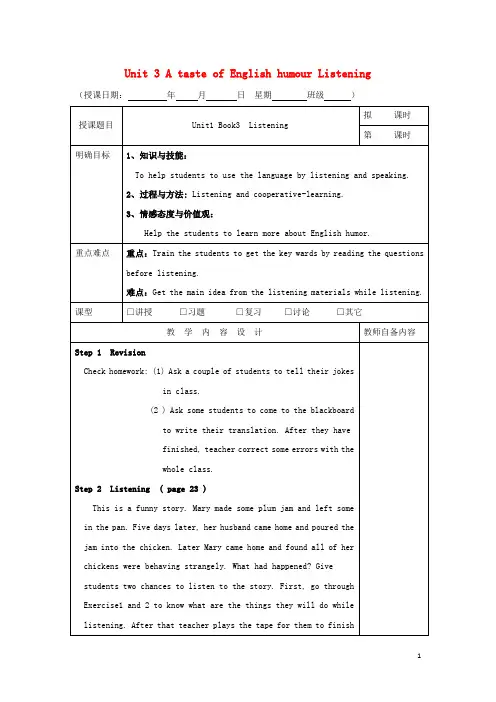
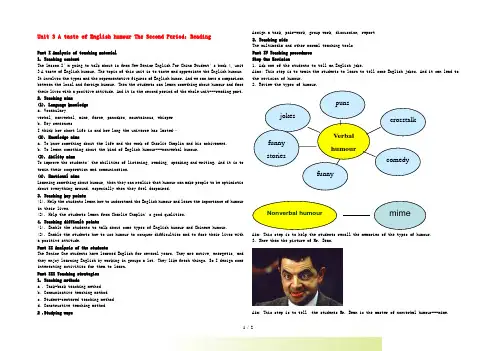
Unit 3 A taste of English humour The Second Period:ReadingPart I Analysis of teaching material1. Teaching contentThe lesson I’m going to talk about is from New Senior English For China Student’s book 4, unit 3 A taste of English humour. The topic of this unit is to taste and appreciate the English humour. It involves the types and the representative figures of English humor. And we can have a comparison between the local and foreign humour. Then the students can learn something about humour and face their lives with a positive attitude. And it is the second period of the whole unit---reading part.2. Teaching aims(1). Language knowledgea. Vocabularyverbal, nonverbal, mime, farce, pancakes, mountainous, whisperb. Key sentencesI think how short life is and how long the universe has lasted…(2). Knowledge aimsa. To know something about the life and the work of Charlie Chaplin and his achivement.b. To learn something about the kind of English humour---nonverbal humour.(3). Ability aimsTo improve the students’the abilities of listening, reading, speaking and writing. And it is to train their cooperation and communication.(4). Emotional aimsLearning something about humour, then they can realize that humour can make people to be optimistic about everything around,especially when they feel despaired.3. Teaching key points(1). Help the students learn how to understand the English humour and learn the importance of humour in their lives.(2). Help the students learn from Charlie Chaplin’s good qualities.4. Teaching difficult points(1). Enable the students to talk about some types of English humour and Chinese humour.(2). Enable the students how to use humour to conquer difficulties and to face their lives witha positive attitude.Part II Analysis of the studentsThe Senior One students have learned English for several years. They are active, energetic, and they enjoy learning English by working in groups a lot. They like fresh things. So I design some interesting activities for them to learn.Part III Teaching strategies1. Teaching methodsa . Task-bask teaching methodb. Communicative teaching methodc. Student-centered teaching methodd. Constructive teaching method2 .Studying ways Assign a task, pair-work, group work, discussion, report3. Teaching aidsThe multimedia and other normal teaching toolsPart IV Teaching proceduresStep One Revision1. Ask one of the students to tell an English joke.Aims:This step is to train the students to learn to tell some English jokes. And it can lead to the revision of humour.2. Review the types of humour.Aim:This step is to help the students recall the memories of the types of humour.3. Show them the picture of Mr. Bean.Aim:This step is to tell the students Mr. Bean is the master of nonverbal humour---mime.Nonverbal humour mimeVerbalhumourjokesfunnystories comedyfunnypoemscrosstalkpunsStep Two Pre-reading1. Enjoy a video of The Gold Rush of Charlie Chaplin.Aims:Enjoying a video can arouse the students’ interests in the lesson and the most important is to introduce Charlie Chaplin--- another master of mime.2. Assign a task. Supposing every one of them is a reporter. And they’re going to write a report to commemorate Charlie Chaplin. And then guide them to do some research of Chaplin, for example his background, cloth, image, work and lifetime, ect.Aim: Students like activities. A task can help the students have the interests to learn the text. Step Three Reading1. Do the research of Charlie Chaplin by finishing some forms. I will ask them to read after the record of the text.Aims:This is a part of the task. So the students will find out the information of Chaplin actively. And reading after the text can train the students’reading English and the tone of speaking English.2. Pair-work. Continue to do the research of Charlie Chaplin by writing down the main idea of each paragraph. Before working, I will ask them to listen to the text.Aims:This is still the part of the task. Writing down the main idea of each paragraph can train the students’ skills of reading and generalization. And it can enhance the understanding of this passage. While listening to the text can train their listening.3. Group work. Answer some questions.Aims:Answering some questions can help the students understand the text better. Besides, group work can train the students’ cooperation and communication.(1) Do you think his poor childhood helped him in his work? Why?(2) Why did people like The Little Tramp?(3) Do you think Chaplin’s eating boiled shoes funny? Why?(4) Why do you think he was so successful?According to the fourth question, they can know Chaplin was determined, persistent, and confident and had his own character. Tell the students to learn from him.Step Four Post-readingGroup work again. Finish the task. Work in groups to discuss how to make a report of commemorating Chaplin. And then ask some students to give us a report in the class. Let’s see who does the report better.Aims:Reporting can train the students’abilities of repeating and generalizing the text. And it can also train their oral English and confidence.Step Five SummarySummarize some information of Chaplin about his living background, clothing, image, and lifetime, ect. And emphasize Chaplin’s good qualities of being successful. We should learn how to face our lives with a positive attitude.Aims:Summary can tell the students the main content of this lesson. Emphasize the teaching key points.Step Six Homework1.Review the text.2.Write a report of commemorating Charlie Chaplin. Aims:Writing a report is to help the students review the text and train their writing ability. Part V Blackboard designUnit 3 A taste of English humourAssign a task. (Write a report of Charlie Chaplin)a. living background1. Do some research of Chaplin. b. clothing and imagec. his work and lifetimeChaplin was great, determined, confident, persistent…2. Finish the task.Part VI Teaching evaluationI hope my teaching of this lesson can achieve the aims and demands. After learning this lesson, the students can achieve the learning aims of this lesson. For example, they can learn something about humour. And they can know how to use humour to face their lives in a positive and an active way. By finishing a series of tasks in this lesson, the students can set up self-confidence in language study, their English skills will be improved, and their learning interest of English will be stimulated, too.。
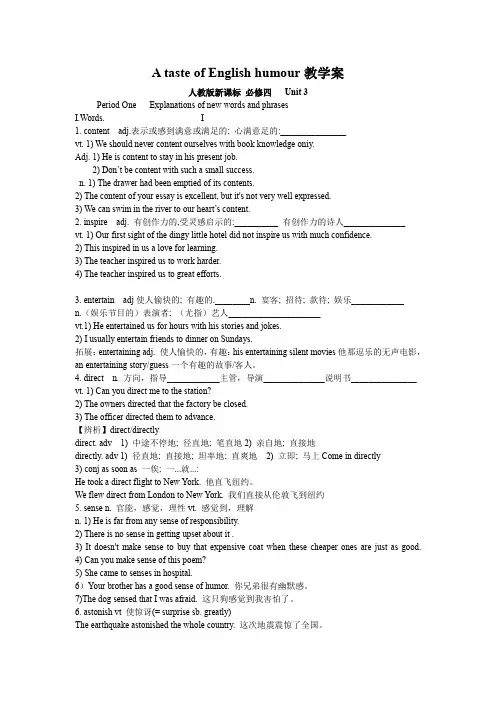
A taste of English humour教学案人教版新课标必修四Unit 3Period One Explanations of new words and phrasesI.Words. I1. content adj.表示或感到满意或满足的; 心满意足的:_______________vt. 1) We should never content ourselves with book knowledge oniy.Adj. 1) He is content to stay in his present job.2) Don’t be content with such a small success.n. 1) The drawer had been emptied of its contents.2) The content of your essay is excellent, but it's not very well expressed.3) We can swim in the river to our heart’s content.2. inspire adj. 有创作力的,受灵感启示的:__________ 有创作力的诗人______________ vt. 1) Our first sight of the dingy little hotel did not inspire us with much confidence.2) This inspired in us a love for learning.3) The teacher inspired us to work harder.4) The teacher inspired us to great efforts.3. entertain adj使人愉快的; 有趣的.________n. 宴客; 招待; 款待; 娱乐____________n.(娱乐节目的)表演者; (尤指)艺人_____________________vt.1) He entertained us for hours with his stories and jokes.2) I usually entertain friends to dinner on Sundays.拓展:entertaining adj. 使人愉快的,有趣:his entertaining silent movies他那逗乐的无声电影,an entertaining story/guess一个有趣的故事/客人。
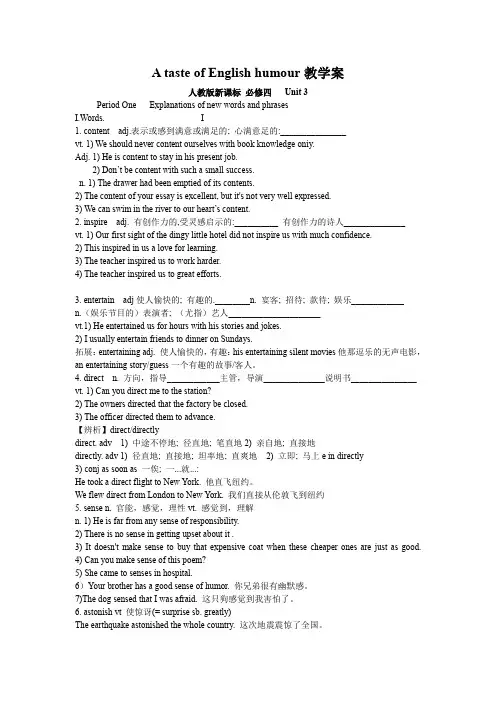
A taste of English humour教学案人教版新课标必修四Unit 3Period One Explanations of new words and phrasesI.Words. I1. content adj.表示或感到满意或满足的; 心满意足的:_______________vt. 1) We should never content ourselves with book knowledge oniy.Adj. 1) He is content to stay in his present job.2) Don’t be content with such a small success.n. 1) The drawer had been emptied of its contents.2) The content of your essay is excellent, but it's not very well expressed.3) We can swim in the river to our heart’s content.2. inspire adj. 有创作力的,受灵感启示的:__________ 有创作力的诗人______________ vt. 1) Our first sight of the dingy little hotel did not inspire us with much confidence.2) This inspired in us a love for learning.3) The teacher inspired us to work harder.4) The teacher inspired us to great efforts.3. entertain adj使人愉快的; 有趣的.________n. 宴客; 招待; 款待; 娱乐____________n.(娱乐节目的)表演者; (尤指)艺人_____________________vt.1) He entertained us for hours with his stories and jokes.2) I usually entertain friends to dinner on Sundays.拓展:entertaining adj. 使人愉快的,有趣:his entertaining silent movies他那逗乐的无声电影,an entertaining story/guess一个有趣的故事/客人。
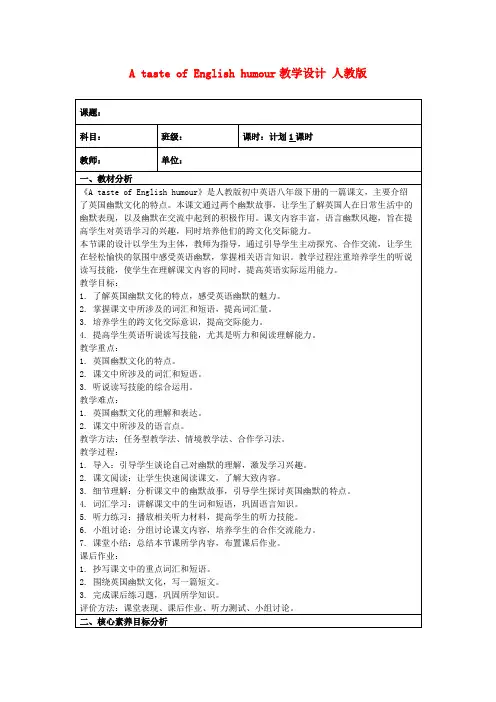
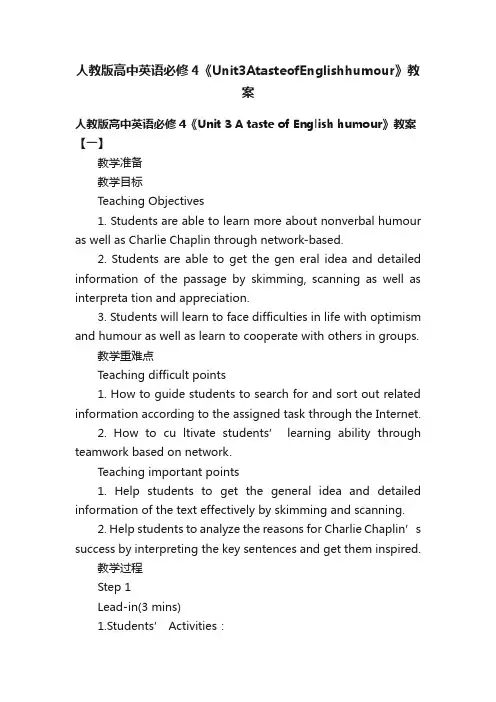
人教版高中英语必修4《Unit3AtasteofEnglishhumour》教案人教版高中英语必修4《Unit 3 A taste of English humour》教案【一】教学准备教学目标Teaching Objectives1. Students are able to learn more about nonverbal humour as well as Charlie Chaplin through network-based.2. Students are able to get the gen eral idea and detailed information of the passage by skimming, scanning as well as interpreta tion and appreciation.3. Students will learn to face difficulties in life with optimism and humour as well as learn to cooperate with others in groups.教学重难点Teaching difficult points1. How to guide students to search for and sort out related information according to the assigned task through the Internet.2. How to cu ltivate stud ents’ learning ability through teamwork based on network.Teaching important points1. Help students to get the general idea and detailed information of the text effectively by skimming and scanning.2. Help students to analyze the reasons for Charlie Chap lin’s success by interpreting the key sentences and get them inspired.教学过程Step 1Lead-in(3 mins)1.Students’ Activities:2.The Purpose of ActivitiesStudents are to appreciate a video clip performed by Mr. Bean.Students will be guided to acquire the form of nonverbal humour in a vivid way,thus eage r to learn about the main character of the text with interest.Step 2Network-based Interactive Learning(25 mins)1.Students’ Activities(1).Students are divided into five groups to search for and sorted out the related information according to the assigned task online(2)A representative of each group is to share the information with the others.2.the Purpose of ActivitiesStudents will develop their ability to effectively sort out information on the Internet throug h group cooperation as well as feel a sense of achievement by their oral presentation.Step3 Text-based Reading(17 mins)Students’ Activities 1. Students are to read the text quickly, and then answer the questions according to the text. 2. Read Paragraph 3 carefully, and then answer the question ---Why did “the little tramp”become Charlie Chaplin’ famous character ?3. Read Paragraph 4 and fill in the blanks。
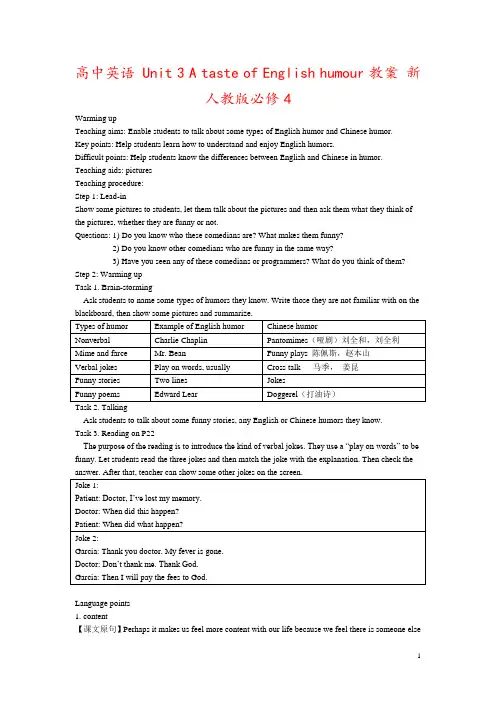
高中英语 Unit 3 A taste of English humour教案新人教版必修4Warming upTeaching aims: Enable students to talk about some types of English humor and Chinese humor.Key points: Help students learn how to understand and enjoy English humors.Difficult points: Help students know the differences between English and Chinese in humor. Teaching aids: picturesTeaching procedure:Step 1: Lead-inShow some pictures to students, let them talk about the pictures and then ask them what they think of the pictures, whether they are funny or not.Questions: 1) Do you know who these comedians are? What makes them funny?2) Do you know other comedians who are funny in the same way?3) Have you seen any of these comedians or programmers? What do you think of them? Step 2: Warming upTask 1. Brain-stormingAsk students to name some types of humors they know. Write those they are not familiar with on theTask 2. TalkingAsk students to talk about some funny stories, any English or Chinese humors they know.Task 3. Reading on P22The purpose of the reading is to introduce the kind of verbal jokes. They use a “play on words” to be funny. Let students read the three jokes and then match the joke with the explanation. Then check theLanguage points1. content【课文原句】Perhaps it makes us feel more content with our life because we feel there is someone elseworse off than ourselves. (P17)【名师点拨】content adj.意为“满足的;满意的”,be content to do意为“乐意去做某事”;be content with sb / sth意为“对某人或某事感到满意”,相当于be pleased with或be satisfied with。
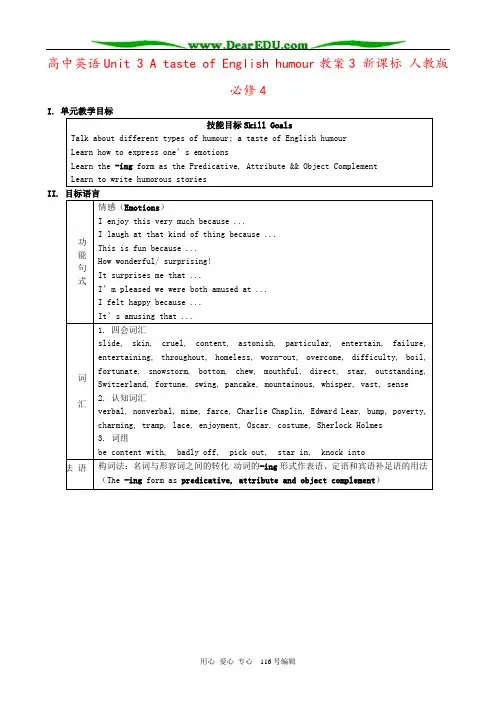
高中英语Unit 3 A taste of English humour教案3 新课标人教版必修4I. 单元教学目标技能目标Skill GoalsTalk about different types of humour; a taste of English humourLearn how to express one’s emotionsLearn the -ing form as the Predicative, Attribute && Object ComplementLearn to write humorous storiesII. 目标语言功能句式情感(Emotions)I enjoy this very much because ...I laugh at that kind of thing because ... This is fun because ...How wonderful/ surprising!It surprises me that ...I’m pleased we were both amused at ...I felt happy because ...It’s amusing that ...词汇1. 四会词汇slide, skin, cruel, content, astonish, particular, entertain, failure, entertaining, throughout, homeless, worn-out, overcome, difficulty, boil, fortunate, snowstorm, bottom, chew, mouthful, direct, star, outstanding, Switzerland, fortune, swing, pancake, mountainous, whisper, vast, sense2. 认知词汇verbal, nonverbal, mime, farce, Charlie Chaplin, Edward Lear, bump, poverty, charming, tramp, lace, enjoyment, Oscar, costume, Sherlock Holmes3. 词组be content with, badly off, pick out, star in, knock into语法构词法:名词与形容词之间的转化动词的-ing形式作表语、定语和宾语补足语的用法(The -ing form as predicative, attribute and object complement)重点句子Do you find it funny to see someone sliding on a banana skin, bumping into someone else round a corner, or falling down a hole in the road? P17Perhaps it makes us feel more content with our life ... P17He became famous for using a particular form of acting, including mime and farce. P17But he was lived by all who watched the films for his determination in overcoming difficulties and being kind even when people were unkind to him.P18Imagine you are hungry and all there is to eat is a boiled shoe. P18 That was the problem facing Charlie Chaplin in one of his most famous films.P18He solved it by using nonverbal humour. P18Their job is “panning for gold”. P18Finally he tries cutting and eating the bottom of the shoe. P18Ⅲ. 教材分析与教材重组1.教材分析本单元的中心话题是“感受英语幽默”,其中涉及到了幽默的种类及其代表人物,并就中外幽默进行了粗略的比较,以此让学生感受英语幽默的内涵。
TEACHING PLAN FOR UNIT 1 Women of achievement【单元教学目标】本单元主要学习为人类作出巨大贡献、取得巨大成就的女性。
学生要了解这些女性的成就以及她们因此而付出的巨大的努力。
本单元warming up部分介绍了六位伟大女性,分别是:Elizabeth Fry, Song Qingling, Jane Goodall, Judy Williams, Joan of Arc, Lin Qiaozhi。
要让学生知道这些伟大女性的生平及其巨大成就。
在阅读理解的第一篇里介绍了Jane Goodall为研究黑猩猩的生活习性而在非洲所进行的野外考察活动。
要引导学生思考:为什么她要进行野外考察?为什么要保护黑猩猩?这篇课文也是进行环境保护教育的好题材。
阅读理解的第二篇则介绍了医学科学家、妇产科专家林巧稚的成就。
【重点与难点】本单元阅读课文所接触的两位伟大女性,学生都比较陌生。
因此,要进行详细的背景的介绍。
本单元主要学习句子的主谓一致。
这也是本单元的难点。
因为汉语动词里面没有单复数的变化,因此,如何让学生掌握“数”的概念,当某些集体名词或连词出现时,如何判断使用单复数?这是一个关键问题。
第一课时【教学目标】本课时主要对课文中出现的六位伟大女性及其成就进行简要介绍。
【重点与难点】课文里边出现了一些名词,如Quaker, China Welfare Institute, campaign等,估计学生不知其意,要进行适当的解释说明。
【教学过程】Step 1 单词复习、听写。
Elizabeth Fry, answer:Step 2 Pictures and QuestionsAsk Ss read the introduction of Elizabeth Fry and answer:What did she do to help the prisoners?Soong Qingling: Who is she? What’s her great achievement?Jane Goodall: What’s her achievement in the study of Chimps?Jody Williams: What did she get in 1997?Joan of Arc: Do you know the name of the girl in ancient China whose experience was similar to her?Lin Qiaozhi: What’s her major?【homework】Recite the new words【课后小结】本课时基本能完成预定的教学任务。
Unit 3 A taste of English humourPeriod 1 Warming-up , pre-reading and reading 本单元的中心话题是“英语幽默”。
其中涉及到了幽默的种类及其代表人物,并就中外幽默进行了粗略的比较,以此让学生感受英语幽默的内涵。
教学该单元是要让学生们认识到,因为中外文化的差异,人们对幽默的理解不同,这往往会引起理解困难;另一方面,通过对各种幽默表现形式的展示,鼓励学生保持乐观的人生态度,培养幽默感,陶冶情操。
一、教学内容及其解析内容:Warming-up, pre-reading and reading解析:Warming-up中提出了三个问题:How many kinds of humour do you know?Do you know these kinds of humour? Do you have other kinds of humour in China?这三个问题直指本单元中心话题,为下一步的阅读理解作了准备。
pre-reading在Warming-up 的基础上提出了另外三个问题:What do you like to laugh at? What does humour mean? Is humour always kind?这三个问题进一步让学生了解幽默的含义,即把缺陷与完美、荒唐与合理、愚笨与机敏等两极对立的属性不动声色地结合起来,在对立统一中见其深刻的意义。
reading以美国著名喜剧大师Charlie Chaplin 的表演为例,为学生展示了幽默的内涵。
目标及解析目标:识记目标词;训练口语能力;引导学生用英语解释单词和短语,使其掌握目标语法:培养学生的阅读能力。
解析:warming-up部分设计了三个练习。
练习1是让学生体会两则笑话里的点睛之笔,引起学生对本单元话题的兴趣。
练习2是一个填表题,主要目的是让学生了解英语幽默艺术的一些国际大师级人物。
Unit 3 A taste of English humourPart One: Teaching Design1. A sample lesson plan for reading(NONVERBAL HUMOUR)AimsTo help students develop their reading ability.To help students learn about English humour.ProceduresI. Warming upWarming up by definin g “Humour〞What is “Humour〞? Does any one of you know anything about humour? Look at the sreen and read the definition of Humour from the Internet.•temper: a characteristic (habitual or relatively temporary) state of feeling; "whether he praised or cursed me depended on his temper at the time"; "he was in a bad humor"•wit: a message whose ingenuity or verbal skill or incongruity has the power to evoke laughter•humor: (Middle Ages) one of the four fluids in the body whose balance was believed to determine your emotional and physical state; "the humors are blood and phlegm and yellow and black bile"•liquid body substance: the liquid parts of the body•humor: the quality of being funny; "I fail to see the humor in it"•humor: the trait of appreciating (and being able to express) the humorous; "she didn't appreciate my humor"; "you can't survive in the army without a sense of humor"•humor: put into a good moodWarming up watching and listeningHi, everyone! We are going to learn about A taste of English humour today. Now watch the slides/ pictures and listen to the English humour poems.Why worry?There are only two things to worry about:Either you are well or you are sick.If you are well, then there is nothing to worry about.If you are sick, there are two things to worry about:Either you will get well or you will die.If you get well, then there is nothing to worry about.If you die, there are only two things to worry about:Either you will go to Heaven or Hell.If you go to Heaven, there is nothing to worry about.But if you go to Hell, you will be so damn busyShaking hands with friends, you won´t have time to worry. Whose job ...?This is the story about four people named Everybody, Somebody, Anybody and Nobody.There was an important job to be done,and Everybody was sure that Somebody would do it. Anybody could have done it, but Nobody did it.Somebody got angry about thatbecause it was Everybody´s job.Everybody thought Anybody could do it,but Nobody realised that Everybody wouldn´t do it.It ended up that Everybody blamed SomebodyWhen Nobody did what Anybody could have doneII. Pre-readingTelling the truth —Why do you like to laugh at?I like to laugh at cartoons,for they’re lovely and fun.I like to laugh at fairy tales. They are amusing and interesting.Many years ago there lived an Emperor who was so exceedingly fond of fine new clothes that he spent vast sums of money on dress. To him clothes meant more than anything else in the world. He took no interest in his army, nor did he care to go to the theatre, or to drive about in his state coach, unless it was to display his new clothes. He had different robes for every single hour of the day.III. Reading1. Reading aloud to the recordingNow please listen and read aloud to the recording of the text NONVERBAL HUMOUR. Pay attention to the pronunciation of each word and the pauses between the thought groups. I will play the tape twice and you shall read aloud twice, too.2. Reading and underliningNext you are to read and underline all the useful expressions or collocations in the passage. Copy them to your notebook after class as homework.Collocations from NONVERBAL HUMOURSlide on…, bump into…, round a corner, fall down…, in the road, see otherpeople’s bad luck, at times, feel content with…, be worse off, astonish…with…, inspire…in sb., play a character, be born in poverty, become famous,3. Reading to identify the topic sentence of each paragrapSkim the text and identify the topic sentence of each paragraph. You may find it either at the beginning, the middle or the end of the paragraph.4. Reading and transferring informationRead the text again to complete the table.Facts about OscarA brief life history of Charlie Chaplin5. Reading and understanding difficult sentencesAs you have read the text times, you can surely tell which sentences are difficult to understand. Now put your questions concerning the difficult points to me the teacher.IV. Closing downClosing down by doing exercisesTo end the lesson you are to do the comprehending exercises No. 1and 2 on pages 18 and 19.Closing down by watching a silent movie by Charlie ChaplinDo you like watching movies? Do you like humourous movies? Now let’s watch a silent humourous movie by Charlie Chaplin. It’s Charlie Chaplin's first film: Making a LivingClosing down by reading about Charlie ChaplinTo end the period we shall read an article about Charlie Chaplin. Now look at the screen and read it aloud with me.2.A sample lesson plan for Learning about Language(The –ing form as the Predicative, Attributive & Object)AimsTo help students learn about The –ing form as the Predicative, Attributive & Object)To help students discover and learn to use some useful words and expressions.To help students discover and learn to use some useful structures.ProceduresI. Warming upWarming up by discovering useful words and expressionsTurn to page 19 and do exercises No. 1, 2 , 3, 4 and 5. Check your answers against your classmates’.II. Learning about The –ing form as the AttributiveWhat is attributive? It is something placed before the nouns to be modified: “red〞is an attributive adjective in “a red apple〞. “walking 〞is also an attributive adjecti ve in “a walking stick〞.III. Ready used materials for The –ing form as the Predicative, Attributive & Object Which verbs can be followed by the -ing form?One of the most important simple principles that grammarians tend tomiss is the one that explains what verbs take the -ing form. Themethod of almost all books on English grammar is to give a list ofsuch verbs. This implies that it is completely arbitrary whether a verbtakes the -ing form or not, that God has closed his eyes and prickedoff verbs here and there at random with a pin. Students are thus cutoff from insight into a basic pattern of meaning, and confronted with alifeless series of unconnected words which they have to learn byheart. They are pushed into a purely mechanical process that missesthe essential truth that learning languages is learning about meaningsand their logical connections to other meanings. It is significant of theimpractical arbitrariness of these lists that there are almost no two ofthem that are the same, even where the most common of the verbsused with -ing are concerned.When contrasting the -ing form with the infinitive, the basic point toremember is that-ing can always mean, among other things, a verb-noun, an'action-thing'.The fact that -ing can always mean a 'thing' gives us the following practical principle:If you can say I (etc.) - verb - it (e.g. I like it), you can use I - verb -ing (e.g. I like eating).Avoid it. Avoid stepping on the grass if you can.Do you mind it? Do you mind shutting the window?He couldn't risk it. He couldn't risk hurting the children.This is a principle virtually without exceptions. But naturally there are many verbs that in practice are never used with -ing simply because nobody ever wants to express that 'action' meaning of -ing with them. The process is always self-regulating, so to speak - one says whatever makes sense. We can look at some examples of the use of -ing with verbs that appear on few, if any, of most grammarians' lists.They have added mistreating prisoners to the list ofcharges.I can't really afford living like this.The council no longer allows smoking in public buildings.aim - (It is hard to think of a sensible example of -ing beingused with this verb. Can you?)The club arranges dancing for the pensioners.The chairman claimed breaking the strike as a greattriumph.I don't count making money as a virtue.The investigators discovered cheating on a huge scale.We must encourage planting earlier in the season.I thank travelling for teaching me much about the humancondition.The principle applies equally to phrasal verbs, both the 'prepositional' type and the 'adverbial particle' type.She insisted on helping me.Bill's putting off writing till tomorrow. (Or: ...putting writingoff..)The managing director picked out idling on the job as themain cause of the declining profits.turn up - (Another example of a verb I am unable to think ofany sensible use for with -ing.)(Notice that in the second and third sentences above, an it used instead of the -ing form would come between putting and off and between picked and out.)There are uses of -ing which appear to contradict the it-substitution principle. Two examples of them involve expressions that both have the sense of continue: carry on and go on. One can say Carry on talking, but not *Carry on it. That, however, is merely becauseunemphasized pronouns are never used at the end of phrasal verbphrases (e.g. in a dictionary one looks it up, not *looks up it). With goon one cannot even say *go it on. This again can be explained simply.One does not *go a thing, while with the sense of continue one doesnot say *go on it for the same reason that one does not say *Carry onit.IV. Closing downClosing down by discoveringTo end the period you are going to skim the text and the previous texts to find out all the examples containing –ing forms used as the predicative, attributive and object.Closing down by exercisesIn the last few minutes you are to do exercises 1, 2, 3 and 4 on page 21. Check your answers against those of your groupmates’3.A sample lesson plan for Using Language(Jokes about Sherlock Holmes and Doctor Watson)AimsTo help students read the paragraph of Jokes about Sherlock Holmes and Doctor Watson To help students to use the language by reading, listening, speaking and writing.ProceduresI. Warming upWarming up by reading school jokesThere are lots of jokes in English about school life. Read these two to see whether you will laugh or not.II. Guided reading1.Reading and translatingRead the paragraph on page 22 and translate it into Chinese sentence by sentence.2. Reading and underliningNext you are to read the paragph and underline all the useful expressions or collocations in it. Copy them to your notebook after class as homework.3. Doing the exerciseNow you are going to do the exercise No. 1 on page 22.III.Guided SpeakingThink of funny stories in English and telll them to your group mates.IV.Guided Writing—Learn to write jokesThere are two main parts to the structure of a joke. The first prepares you for the laugh by telling a story which creates a sense of expectation. The second part of the joke, the punch line, provokes laughter by telling an unexpected and different story, yet one which is still compatible with the first, as in this example: "My wife just ran off with my best friend. Boy, do I miss him." and "I had a mud pack facial done, and for three days my face looked much better. Then the mud fell off." Notice the assumption that is made in both these examples. In the first, you assume the person telling the story is angry with his wife, so the punch line surprises you because he's feeling something different and unexpected. Again, in the second example, you'd most likely assume the mud had been removed, leaving the face looking better, so the punch line takes you by surprise.So, to write jokes you need to practice reading statements and writing down the asumptions you make about them. You must be able to interpret the statement (first story line) in at least two different ways in order to provide the second, different story i.e. the punch line. And what to write about? Anything that interests you. Anything you have strong opinions about.Now write down your own jokes, in English.IV. Closing down by actingTo end this period, we are going to act the film by Charlie Chaplin The Great Dictator.Part Two: Teaching Resources1.A text structure analysis of NONVERBAL HUMOUR I. Type of writing and summary of the ideaII. A tree diagram of the text THEME PARKS —FUN AND MORE THAN FUNA possible version:Sliding on a banana skin. Bumping into someone. Falling down a hole. These are some of the funny things we like to see other people doing. We feel content with ourselves because thes e other people are worse off than we are. And this feeling is so called “humour〞. Charlie Chaplin is a humourous actor. He astonishes us with humourous feelings he inspired in us. Born in poverty, he became famous by using a particular form of acting in entertaining silent movies. He was a charming character, being well known throughout the world. He played a poor and homeless person, wearing large trousers, carrying a walking stick. Be a social failure, he was, in the movies, loved by all the people. By overcoming difficulties, by being kind to people unkind to him, by making a sad situation entertaining, by eating a boiled shoe, Charlie Chaplin make us happy and excited. His use of nonverbalhumour excellent in the film The Gold Runed in the middle of the nineteenth century in ,California where gold was dicovered. In search of gold people rushed there, panning for gold, washing gold from water in a pan of water, hoping to ipick up gold.Such is Charlie Chaplin who produced, directed, and wrote movies that he starred in. He was given a special Oscar in 1972 for his lifetime outstanding work of bringing humour to us all.2.Background information on theme parksI. Six ways to improve your nonverbal communications1. Eye contact:Eye contact, an important channel of interpersonal communication, helps regulate the flow of communication. And it signals interest in others. Furthermore, eye contact with audiences increases the speaker's credibility. Teachers who make eye contact open the flow of communication and convey interest, concern, warmth and credibility.2. Facial expressions:Smiling is a powerful cue that transmits:•Happiness•Friendliness•Warmth•Liking•AffiliationThus, if you smile frequently you will be perceived as more likable, friendly, warm and approachable. Smiling is often contagious and students will react favorably and learn more.3. Gestures:If you fail to gesture while speaking, you may be perceived as boring, stiff and unanimated. A lively and animated teaching style captures students' attention, makes the material more interesting, facilitates learning and provides a bit of entertainment. Head nods, a form of gestures, communicate positive reinforcement to students and indicate that you are listening.4. Posture and body orientation:You communicate numerous messages by the way you walk, talk, stand and sit. Standing erect, but not rigid, and leaning slightly forward communicates to students that you are approachable, receptive and friendly. Furthermore, interpersonal closeness results when you and your students face each other. Speaking with your back turned or looking at the floor or ceiling should be avoided; it communicates disinterest to your class.5. Proximity:Cultural norms dictate a comfortable distance for interaction with students. You should look for signals of discomfort caused by invading students' space. Some of these are: •Rocking•Leg swinging•Tapping•Gaze aversionTypically, in large college classes space invasion is not a problem. In fact, there is usually too much distance. To counteract this, move around the classroom to increase interaction with your students. Increasing proximity enables you to make better eye contact and increases the opportunities for students to speak.6. Paralinguistics:This facet of nonverbal communication includes such vocal elements as: •Tone•Pitch•Rhythm•Timbre•Loudness•InflectionFor maximum teaching effectiveness, learn to vary these six elements of your voice.One of the major criticisms is of instructors who speak in a monotone. Listeners perceive these instructors as boring and dull. Students report that they learn less and lose interest more quickly when listening to teachers who have not learned to modulate their voices.7. Humor:Humor is often overlooked as a teaching tool, and it is too often not encouraged in college classrooms. Laughter releases stress and tension for both instructor and student. You should develop the ability to laugh at yourself and encourage students to do the same. It fosters a friendly classroom environment that facilitates learning. (Lou Holtz wrote that when his players felt successful he always observed the presence of good humor in the locker room.)Obviously, adequate knowledge of the subject matter is crucial to your success; however, it's not the only crucial element. Creating a climate that facilitates learning and retention demands good nonverbal and verbal skills. To improve your nonverbal skills, record your speaking on video tape. Then ask a colleague in communications to suggest refinements.II. Biography of Charlie ChaplinCharlie Chaplin was born Charles Spencer Chaplin in London, England on 16 April 1889. His parents, Charles Chaplin, Sr and Hannah Hill were music hall entertainersbut separated shortly after Charlie was born, leaving Hannah to provide for her children. In 1896 when Hannah was no longer able to care for her children, Charlie and his brother Sydney were admitted to Lambeth Workhouse and later, Hanwell School for Orphans and Destitute Children.Charlie had already debuted in the music hall in 1894, when he had sung a song after his mother was taken hoarse.1903-1906Performs in Sherlock Holmes, as the newspaper boy Billy1906-1907The Casey Circus1907-1910Works with the Karno Pantomime Troupe1910-1912First tour of USA/Canada with Karno Troupe1912-1913Second tour of USA/Canada with Karno TroupeMay 1913Accepts offer from Adam Kessel (who has interests in the Keystone Film Company) for $125/week29 December 1913Signs contract with KeystoneJan/Feb 1914Charlie Chaplin's first film: Making a Living1914Keystone filmsNov 1914Signs with Essanay for $1,250/week to make 14 films during 19151915Essanay films27 Feb 1916Signs with Mutual Film Corporation for $10,000/week plus $150,000 bonus1916-1917Mutual films17 June 1917Signs with First National Exhibitor's Circuit for $1,075,000/year2.Words and expressions from Unit 3 A taste of English humourverbal a. verbal skill 运用语言的能力I wrote a memorandum to confirm our verbal agreement. 我写了份备忘录以确认我们的口头协议。
A teaching deignUnit 3 A tate of Engih humourA reading eonI Anai on Learner:Senior high tudent are eager to earn omething unnown The’re not content with the imited nowedge obtained from the tetboo So I mut tr m bet to rich m eon to he ee: 1 Knowedge aim:Get tudent to earn the foowing uefu new word and eour , homee, u1 Tr to imming abiit2 Mater the uage of “ing〞3 Emotiona aim1)Let tudent have a better undertanding of Charie’ hard ife2)DeveoimB Imater the meaning and uage of imeaning of word in a contetIII Teaching Method1.1 Ta-baed teaching autimedia caroom2.the bacboardV Teaching inSteinGreetingT: Heo, everone! Do ou eno watching mime actor Mr BeanS: YeT: whS: Becaue hi mime…T: Ye, I agree with ou But, toda I’ introduce another mime mater ——Charie Cha Do ou want to now more about him O, et’ turn to inA Fat reading 5minFirt, I’ et tudent read the to fi in the form on to match the content with each ent ou fim character[Here I’ tr to deveoming and canning abiit]B Carefu reading 2021nI’ a tudent to read the find out the main entence of each e time, I’ a them to find out ome im two or four minute for each in1 I’ a tudent to anwer the foowing five quetion:1)Wh did ot famou character ie2)Can ou give an eamade funn3)What were hi achievement2 I’ a them to ae a ummar of the reading3 I’ mar and homewor2min1.Ue one or two entence to mae a ummar of the tet2.Aign homewor。
Step one: Greetings
Greet the whole class as usual.
Step two: Lead-in
I’m very glad to give you a class. Today, we’ll talk about something about humor. But before the class, let’s look at the screen. Please enjoy the proverb:
A smile always makes a young man.
Do you know what this proverb is about? Yes, good. It’s about laughter. Laugh is very important in our life because It can brighten up our daily life It is also good for our health. So do you want to laugh? Pay attention to the screen.
Picture one is a man, he is driving a cow with wheels at a high speed, on a freeway I guess. Picture two is a little kid, but he is so strong. They’re very interesting and humorous. But stop here; we cannot watch another one, ’cause the proverb goes:” A smile makes a young man”. So you are too young to laugh more than twice. Otherwise you will be like this.
Oh Gee. Thank God, you didn’t laugh that hard
Who is the most humorous person in the world? Maybe it’s Charlie Chaplin.He was one of the most famous humorists that can make others laugh all the time. He was a great silent movie star. His acting was so amazing that sometimes you may find him a genius full of imagination. Here is an example from his movie: Think about this question: If you are very hungry will you eat a pair of shoes? But Charlie Chaplin did. Now look at the screen carefully:
What do you think about this?
His acting is convincing.
OK. Today, we will learn more about him.
Step three: Fast Reading
Please turn to page 18. Let’s see the passage --- A Master of Nonverbal Humor. Listen to the tape and then find out the answers to some questions. You can follow the tape.
Questions:
1. Notes about Charlie Chaplin’s career
2.Find out the main idea of each part.
Step four: Careful Reading
Through fast reading we’ve known the main idea about this passage. Now let’s understand the text paragraph by paragraph.
Para one: Read this paragraph together, and then find out the answer to the question.
What effect does Charlie Chaplin's acting have?
He made people laugh at a time when they felt depressed, so they could feel more content with their lives.
Part two: Let the students read it silently, then answer the following questions.
1. When was he taught to sing and dance?
As soon as he could speak and walk.
2. How did he spend his childhood after his father died?
He spent his time looking after his mother and his brother.
Part three: Listen to the tape, and then answer the questions.
Can you give a description on the little tramp?
Large trousers, worn-out shoes, small round black hat and a walking stick
All his appearance makes the little tramp a poor and homeless person
Para four: Listen to the tape of paragraph four, and then answer questions.
1. Read Para 4 and answer the questions about The Gold Rush.
Time:In the middle of the 19th century Place:California
2. Can you put them in a right order?
a. Cut off the leather top of the shoe 3
b. Pick out the laces and eat them 2
c. Try cutting and eating the bottom of the shoe 4
d. Sit down at the tabl
e. 1
Para five: Read it together, and then fill in the blanks.
Step five: Discussion
From this passage, we can see that Charlie Chaplin is a successful actor. Now think about this: why was he so successful? What should we learn from him?
Step six: Sum-up
From what you said, we can conclude some reasons for his success. Firstly, determination: from the passage we know that when he was a child he has made up his mind to be a good actor. Secondly, he is the underdog just like his famous character—the little tramp. His miserable childhood makes him have a strong sympathy to the poor. And just as the little tamp did, he is optimistic to life and also, his devotion to his career plays an important part in his success. More over, He is kind; from his works we can see that.
I think these are what we should learn from him
Step seven: Homework
Write a composition about Charlie Chaplin in English for the local newspaper.
Related website: http://www.Charlie 。